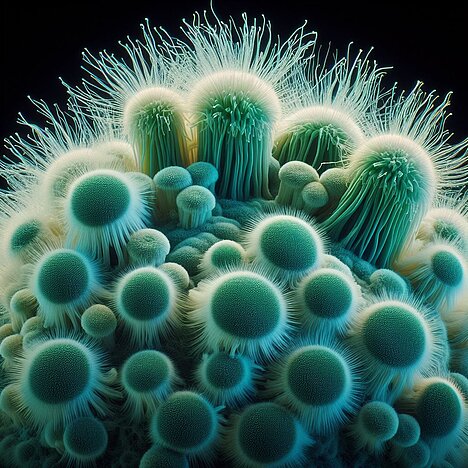Penicillium chrysogenum

Penicillium chrysogenum is a species of mold from the genus Penicillium. These fungi are distributed worldwide and live predominantly in dead, decomposing organic matter. They play a significant role in the material cycle in the earth's ecosystems. Penicillium chrysogenum is best known as the source of the antibiotic penicillin, which is obtained from the metabolic product penicillin G that it produces. But what does this fungus have to do with dogs? Is it beneficial or harmful to them? In this article you will learn more about the pros and cons of Penicillium chrysogenum in relation to dogs.
Benefits of Penicillium chrysogenum for dogs
The most obvious benefit of Penicillium chrysogenum for dogs is the ability to use penicillin as an antibiotic to treat bacterial infections. Penicillin is one of the oldest and most commonly used antibiotics in veterinary medicine. It is effective against a wide range of bacteria that can cause various diseases in dogs, such as skin infections, respiratory infections, urinary tract infections, ear infections or wound infections. Penicillin is generally well tolerated and has few side effects in dogs. It can be administered orally or intramuscularly.
Another possible benefit of Penicillium chrysogenum for dogs is the stimulation of the immune system. Some studies have shown that exposure to molds such as Penicillium chrysogenum can boost the immune system of animals by increasing the production of antibodies and cytokines. This immune response can help to ward off infections or reduce allergic reactions. However, this effect has not yet been clearly proven and depends on many factors, such as the type, amount and duration of exposure to the fungus.
Disadvantages of Penicillium chrysogenum for dogs
The main disadvantage of Penicillium chrysogenum for dogs is the risk of an allergic reaction. Penicillium chrysogenum is one of the three most common indoor airborne fungi (along with Aspergillus and Cladosporium). These fungi can cause allergy symptoms when inhaled. Symptoms can include: Sneezing, coughing, itching, skin rash, eye irritation or asthma. The severity of the symptoms depends on the sensitivity of the dog, the concentration of fungal spores in the air and the duration of exposure. Treatment for a fungal allergy may include antihistamines, corticosteroids or immunotherapy.
Another potential disadvantage of Penicillium chrysogenum for dogs is the risk of fungal infection. Although Penicillium chrysogenum is not normally a pathogenic fungus, it can cause an infection under certain circumstances. This can happen especially in dogs with a weakened immune system due to an existing disease or immunosuppressive therapy. A fungal infection can affect various organs, such as the lungs, skin, ears or nails. The symptoms of a fungal infection can be Fever, shortness of breath, coughing, weight loss, hair loss, skin changes or lameness. Treatment of a fungal infection may require antifungal medication, surgical removal or amputation.
Penicillium chrysogenum is a mold that can have both benefits and drawbacks for dogs. It is the source of the antibiotic penicillin, which can cure many bacterial infections in dogs. It can also boost dogs' immune systems when inhaled in small amounts. However, it can also trigger allergic reactions or fungal infections in dogs if inhaled in high concentrations or over a long period of time. Therefore, it is important to control dogs' exposure to Penicillium chrysogenum and avoid them eating or licking spoiled food or materials contaminated with the fungus.
If you notice any signs of hypersensitivity or poisoning in your dog, you should see your vet immediately. We are not a substitute for a vet, but we try to be as accurate as possible. Every dog reacts differently and we recommend you get a second opinion or consult your vet if in doubt.
Stay healthy and take good care of your four-legged friend!😊